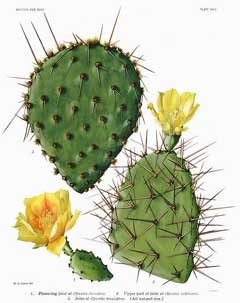
Eastern Prickly Pear, Prickly Pear Cactus
Latin Name: Opuntia compressa
USDA Hardiness: 8-10
Native Range: NORTHERN AMERICA: United States, Connecticut, Massachusetts, New Jersey, New York, Pennsylvania, West Virginia, Nebraska, Oklahoma (east), Delaware, Louisiana, Maryland, Mississippi, Virginia, District of Columbia, PACIFIC: Fiji, Nansei-shoto, Tuamotu, Vanuatu
Edibility Rating: 3 / 5
Medicinal Rating: 1 / 5
Region:
Family:
Plant Type:
Medicinal Uses
Edible Uses
Edible Parts: Fruit Leaves Seed | Edible Uses: GumFruit - raw, cooked or dried for later use[3, 46, 61, 62, 183]. Sweet and gelatinous[85]. Lean and insipid[95]. The unripe fruits can be added to soups etc, imparting an okra-like mucilaginous quality[183]. The fruit can hang on the plant all year round[160]. The fruit is up to 4cm long and 3cm wide[200]. Be careful of the plants irritant hairs, see the notes above on toxicity. Pads - cooked or raw[62, 160]. Watery and very mucilaginous[85]. Seed - briefly roasted then ground into a powder[62]. It is also used as a thickener[62].
Cultivation
Landscape Uses:Alpine garden, Border, Container, Rock garden, Seashore.Requires a sandy or very well-drained soil[160]. Prefers a pH in the range 6 to 7.5[200]. Must be kept fairly dry in winter but likes a reasonable supply of water in the growing season[200]. A position at the base of a south-facing wall or somewhere that can be protected from winter rain is best for this plant. Requires warmth and plenty of sun. Plants tolerate considerable neglect. Plants are very cold-hardy, tolerating temperatures down to about -30°c[160], but they are intolerant of winter wet. There is considerable confusion over the correct name for this species, several of the synonyms listed above are also applied to other species in this genus. Special Features:Attracts birds, North American native, Attractive flowers or blooms. The plant is heat tolerant in zones 12 through 9. (Plant Hardiness Zones show how well plants withstand cold winter temperatures. Plant Heat Zones show when plants would start suffering from the heat. The Plant Heat Zone map is based on the number of "heat days" experienced in a given area where the temperature climbs to over 86 degrees F (30°C). At this temperature, many plants begin to suffer physiological damage. Heat Zones range from 1 (no heat days) to 12 (210 or more heat days). For example Heat Zone. 11-1 indicates that the plant is heat tolerant in zones 11 through 1.) For polyculture design as well as the above-ground architecture (form - tree, shrub etc. and size shown above) information on the habit and root pattern is also useful and given here if available. A clumping mat former. Forming a dense prostrate carpet with a limited spread [1-2]. The root pattern is fibrous dividing into a large number of fine roots [1-2]. The fruits (tunas) are typically harvested in late summer to autumn, around late summer to early fall, depending on the species and climate. Opuntia species usually flower in late spring to early summer. They generally grow moderately fast, and many species can produce new pads and fruit within the first year of planting, especially in favorable conditions. Many Opuntia species are self-fertile, though cross-pollination can improve fruit set and quality.
Known Hazards
The plant has numerous minutely barbed glochids (hairs) that are easily dislodged when the plant is touched and they then become stuck to the skin where they are difficult to see and remove. They can cause considerable discomfort[200].
Habitats
Opn dry areas[274]. Rocky bluffs, sand dunes, dry rocky or sandy grasslands.
